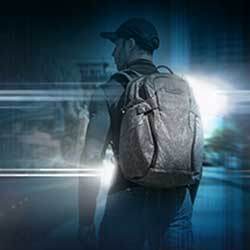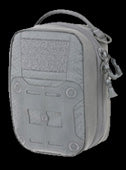Emergencies are inevitable; the world is brimming with natural and human activity that can threaten your day-to-day life. It's easy to freak out when being torn away from the comforts of your routine, struggling with what's the right course of action to take... but you can figure that out ahead of time. You can be prepared so you’ll be cool & collected when disaster strikes - which in turn will enable you to better protect yourself as well as your loved ones. By educating yourself now and gathering the necessary supplies, you can reassure yourself that you’ll be ready for any danger that comes your way. Watch and learn about must-have gear for emergency backpacks, often referred to as “bug out” bags or “grab and go” bags, in the third season of Maxpedition Survival Tips!
On top of making a plan in advance - practicing drills with your family or colleagues, noting escape routes and where to find shelter, etc - you need to have emergency supplies. Thomas Coyne, founder and owner of Coyne Survival Schools, elaborates on why this is essential in episode 1. “You can’t carry a policeman, a firefighter, or a paramedic in your pocket,” he says. It’s about being self sufficient. Don’t depend on help to be readily available because there’s a chance it won’t be when you need it most.
Building these kits beforehand means they’ll be ready for you to engage the very moment there’s a crisis, and different crises may warrant different supplies. For the rest of the videos in this series, Coyne reveals what makes a great kit by disassembling three different kinds: the Disaster Bug Out bag, Urban Escape & Evasion bag, and Vehicle Get Home bag. He demonstrates with the Maxpedition Tiburon™, Entity 23™, and Riftcore™ respectively.
A Disaster Bug Out bag is your go-to pack when your home just isn't safe anymore. Earthquakes, fires, hurricanes, as well as man-made disasters can make it necessary to evacuate the area immediately. This pack often times is the biggest of any other emergency pack because it should be prepped for a multiple day, multiple terrain survival expedition.
A bag that supports you through an extended trek needs to be significant in size, and the Tiburon™ backpack is definitely just that at 34 liters large. It is spacious, compartmentalized, and built extremely tough. Its MOLLE-compatible exterior and hook & loop field interior adds customizability, which makes it easy to organize all your life-saving equipment.
The full list of the contents shared in the video is as follow: Urban water filter; Medical kit - Maxpedition LTB™ Lightweight Toiletry Bag; Sleeping bag; Tarp emergency blanket; 1000 lb strong kevlar cord; Stainless steel canteen cup; Canister stove; Freeze dried meals; Portable charger; GPS; 2-way radio / walkie talkie; Tactical light; Headlamp; Power inverter; GPS; Locator beacon; Chemical glow stick; Pen flare; Compass; 10ft of duct tape around a pencil; Swiss army knife; MREs; Pocket shower.
The Urban Escape & Evasion bag becomes your fighting chance in city-centric, human campaigns of violence. Riots, disorderly public protests, and terrorist attacks leave many people scared and mostly unsure of how to react. Safety naturally becomes your number one priority, and sometimes it may not be safe to stay home. In extreme circumstances where leaving your home is the only remaining option, navigating the streets during these times becomes much more feasible and less daunting when you have a pack properly equipped to aid you on your journey.
Because this next episode centers around traversing urban areas, it is ideal to keep a low-profile so as to not draw unwanted attention. Coyne trusts the design of Maxpedition’s Entity series to fulfill that key component, for the entire line was developed with the grayman theory in mind. In Episode 3, he presents the Entity 23™. The gear he has packed inside maximizes his survival chances in hostile city situations.
The first thing Thomas Coyne unpacks is bear mace. For crowd dispersal, this is the perfect tool for clearing a path to safety for yourself without harming anyone. He also carries a gas mask not only for his own sake should he need to utilize the bear mace, but for protection against any other form of air chemical attacks. For obtaining drinking water, he carries an advanced water filter that can properly remove heavy metals, pesticides, herbicides, viruses and more; this is important because pollution and contamination is much more serious in urban areas than in the wilderness. Additionally, he has a portable reservoir so he can pre-treat his water before running it through his filter. At the end of the episode, he shows off the secret concealed carry compartment of his Entity 23™ backpack. Within it are his escape tools, which he can use to get in or out of most residential and commercial buildings as well as escape handcuffs.
The full list of items featured is as follows: Bear mace; Gas mask; Tactical light; Flash bang simulator; MREs; Urban water filter; Portable reservoir; Heat sheet; Chemical hand warmers; 1000 lb strong kevlar cord; Power inverter; Portable charger; 2-way radio / walkie talkie; GPS; Headlamp; Work gloves; Medical kit - Maxpedition FRP™ First Response Pouch (which holds Gauze sponges; Nonstick dressing; Waterproof tape; Emergency shears; Tourniquet; Chest seals; Hemostatic dressing; Israeli bandage; and Medical gloves); Escape Tools kit.
Your Vehicle Get Home bag is different from the other packs in that it should always be kept in your vehicle. If you’re not at home, you are often outside somewhere in or near your car. When there’s a disaster, sometimes simply driving away isn’t an option; urban disturbances can lead to gridlock across major highways and natural disasters can make staying on the road extremely dangerous. Should you find yourself in such a situation where it is imperative to escape on foot, having a pack securely stowed in the back or in the trunk gives you extra leverage to get to a place of safety.
Survival fans and students may recall seeing Thomas Coyne rocking his tan colored Riftcore™ during his classes, as it actually makes for the perfect bag for a variety of different scenarios. The grey Riftcore™ seen in this season's episode 2 is being used as his Vehicle Get Home bag, and he has it fully equipped with all the necessary tools and supplies to make his way back home from any unexpected complication he could encounter in the city.
Coyne has continually stressed that "if you have one light, you have none." He carries two types of lights: a tactical light which alternatively acts as a self-defense weapon, and a headlamp which enables him to work hands free. In the middle compartment (using the multiple loop-lined adjustable straps that comes with the Riftcore™), Coyne has stowed away a trusty axe, which he exclaims can be used "not only for self-defense, but for cutting someone out of a damaged vehicle, prying things, getting rid of the metal, the glass" and more.
The full list of items shown in the video is as follows: Flash bang simulator; Bear mace; Swiss army knife; Chemical glow stick; GPS; GPS locator beacon; Pen flare; Urban water filter; Medical kit - Maxpedition LTB™ Lightweight Toiletry Bag; Work gloves; walkie talkie; Tarp emergency blanket; 1000 lb strong kevlar cord; Compass; Headlamp; Portable charger; MREs; Axe; Tactical light.
Now the Disaster Bug Out bag, Urban Escape & Evasion bag, and Vehicle Get Home bag are built especially for their respective themes. Any one of these kits are strong as it is, but keep in mind that you can enhance them by taking into consideration your own lifestyle and location. For example, you are more likely to face hurricane threats if you live along the shorelines across the east coast of the United States; you may want to protect your emergency supplies with an RFY Rain Cover, which conveniently stows away in a secret bottom pocket on the Tiburon™ backpack. This advice plus much more is published by Maxpedition to help its audience have a better understanding of their gear and the world around them. With all the ways things could go wrong in everyday life, there's just as many ways to be ready to face them with confidence.
Stay informed when new episodes of Maxpedition Survival Tips are available by subscribing to our Youtube channel. Here on Maxpedition.com, join the mailing list for first looks into new products, upcoming videos and special offers!
About Coyne Survival Schools:
https://www.californiasurvivaltraining.com
"We are here to get you ready for the real thing. All courses are led by former first responders and veterans. Our training is not based on what you'll find in all the same old survival manuals or YouTube videos. It's based on real world experience, in extreme climates and terrains- globally. This is why 3 branches of the United States Military have chosen us for a wide range of training, and we hope you and your family (yes we have training for all ages and skill levels) do as well."











